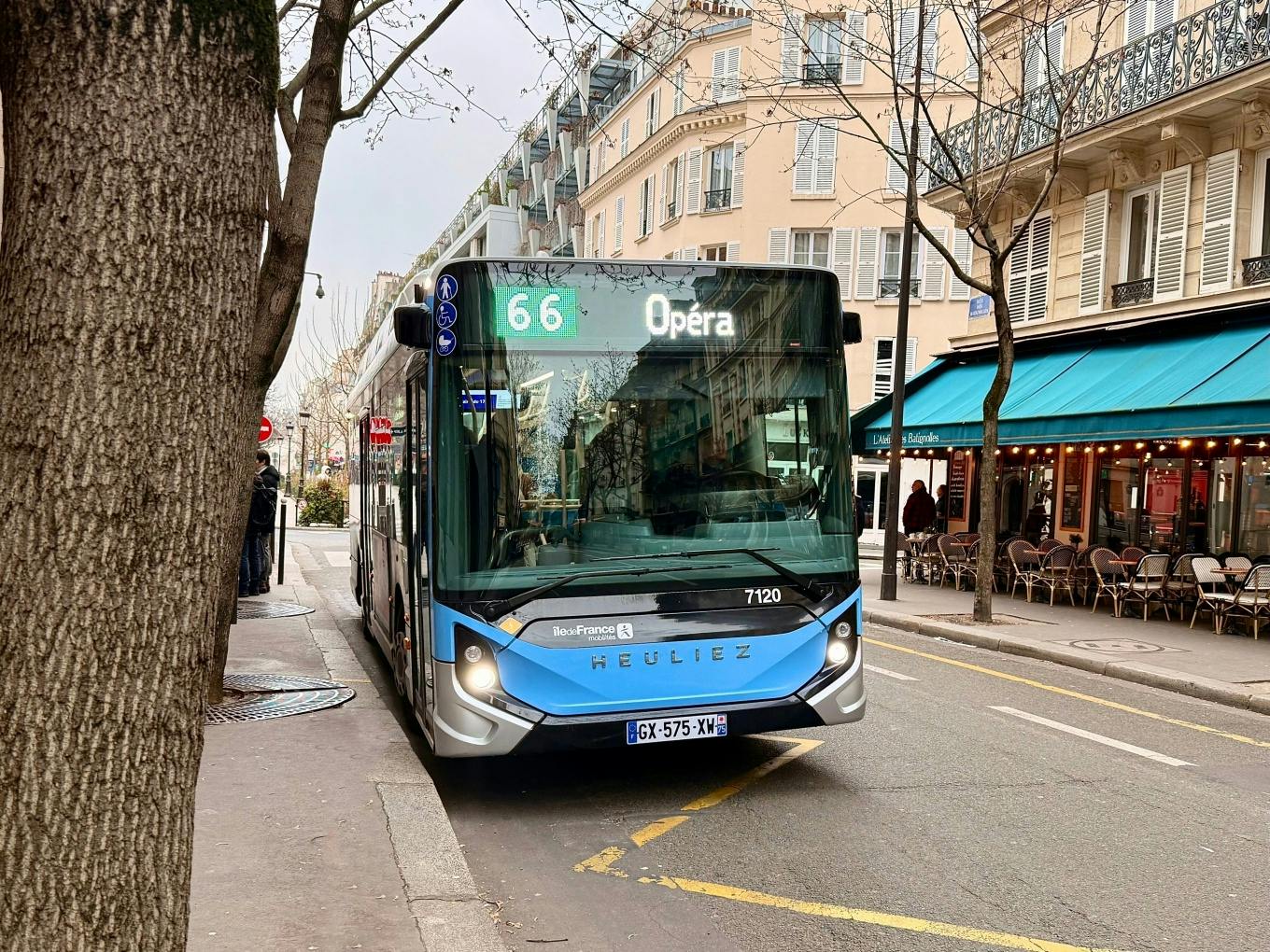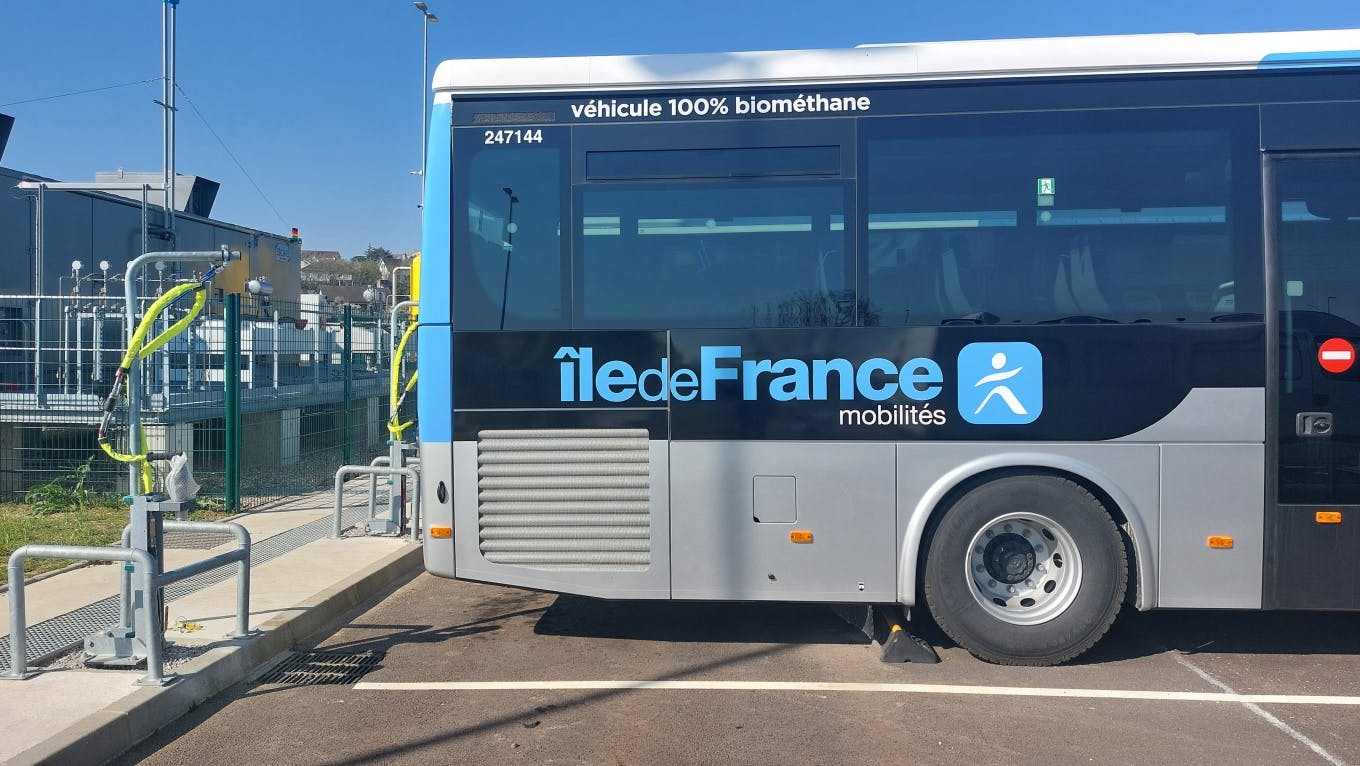Electricity, biomethane: sustainable buses, for a strong ecological commitment

With nearly 3.9 million daily journeys made in part or in whole by bus, every day, on more than 1900 lines : Île-de-France Mobilités' bus network is one of the densest in the world. And soon, one of the most economical in terms of CO2 emissions.
To achieve this, Île-de-France Mobilités has been committed since 2018 (in collaboration with all transport operators) to the most ambitious programme in Europe to achieve decarbonisation.
The objective? The total decarbonisation of the region's buses and coaches by 2029. Before the decarbonisation of all modes of transport by 2050.
Clean buses all along the line
An ambitious objective that involves investing in new vehicles, choosing the energies that will run your buses, but not only!
More sustainable mobility is thought of at all levels of the transport chain.
1) In 2025, the bus and coach network will run on clean energy in urban areas
In Île-de-France, vehicles that still run on diesel will all be converted, from 2025, to hydrogenated vegetable oils (or HVO): a cleaner fuel, composed of used vegetable and cooking oils, compatible with diesel vehicles, which will be used for the propulsion of the latter.
Île-de-France Mobilités has chosen a mix composed of 70% biomethane and 30% electric, which aims to guarantee better energy sovereignty for the Île-de-France bus network.
2) 4,000 new clean coaches and buses will arrive on the lines between 2025 and 2028
As of 1 July 2025, just over 5,172 vehicles (buses and coaches) will run on sustainable energy.
And this is just the beginning, as Île-de-France Mobilités plans to order 4,000 new electric or biomethane buses and coaches.
A total of 4,000 vehicles will be put on the road, with an average of 1,000 per year, between 2025 and 2028.
3) Conversion: no clean buses without deposits (or "COB" for "operational center buses") of their own
Indeed, these real "bus houses" must be equipped to accommodate electric or biomethane-powered vehicles. To this end, Île-de-France Mobilités has embarked on an ambitious operation to transition its COBs to clean energy.
As of July 1, 2025:
- 65 Bus Operations Centres have already been converted (20 are under construction)

Example of a depot for clean buses
4) Anaerobic digestion: support for local and virtuous production sectors
To drive greener, you need... green energy and when it is local, it is even better. Île-de-France Mobilités supports the organisation and development of a methanisation sector (this is how biomethane or green gas is manufactured) in Île-de-France*.
As of 1 January 2025, Île-de-France has 57 anaerobic digestion facilities covering all stages, from waste recycling to gas storage.
*subsidized by the Île-de-France Region
Energy transition: everything you need to know about clean buses in Île-de-France
Clean energy: what do your buses run at in Île-de-France?
While the majority of conversions are to biomethane (2,700 buses on 1 July) or electricity (1,138 buses on 1 July), other environmentally friendly energy sources are used and tested on your lines.
As of July 1, 2025:
- 2 vehicles are experimenting with hydrogen and will be joined by 47 new ones by 2027.
How do you choose the energy that will be used on one bus line or another?
The choice of one energy or the other is made according to the need and the type of lines.
Between electric and biomethane, the choice was simple.
Electrical energy
Electric isparticularly suitable for buses that do not travel very long distances, but also for depots directly adjacent to dense residential areas.
Biomethane or BioNGV
Elsewhere, green gas or biomethane, which has been tried and tested for more than 20 years and offers the same range as diesel, has been chosen.
But be careful: not just any gas! In partnership with GRDF, BioNGV has been selected by Île-de-France Mobilités.
What exactly is biomethane (or BioNGV)?
Biomethane: a host of advantages
With local production and use, BioNGV offers real advantages for the territory in which it is developed. It is fully part of a virtuous circular economy for the environment and the territories:
- Reduction of greenhouse gas emissions and improvement of air quality : it offers an 80% reduction in CO2 emissions compared to a diesel vehicle of the same generation and 90% fewer particles.
- With its Crit'Air 1 sticker, it has access to all low-emission zones and can drive all year round in urban areas.
- It generates jobs : the green gas sector creates 4,000 jobs that cannot be relocated today and 53,000 by 2030, solely in operation and maintenance. A production that tends towards the country's energy independence.
- It participates in the circular economy : thanks to local production and use, it places local authorities at the heart of the circular economy, which uses it for their transport and waste collection. Waste is collected with fuel from the same waste (this is the case for the household waste trucks in the city of Paris).

100% electric bus: we take stock
More recent in the sector, electric technology using slow charging at the depot is the main one used today by Île-de-France Mobilités.
Electric energy, you already use it
It is already used in trains, metros and many private vehicles - from cars and scooters to scooters and bicycles – this is electric energy. And Île-de-France Mobilités, as we have seen, reserves it for buses that run in dense urban areas.
Île-de-France Mobilités uses this energy by organising the "slow charging" of its buses, directly at the depot. But traffic in dense urban areas allows for another mode of charging called "by opportunity": this means that the bus can take advantage of a long stop or a passage at the terminus to connect to the electricity grid. A charging strategy implemented initially for vehicles on the T Zen 4 line.
Experimentation: in search of the energy of tomorrow
Île-de-France Mobilités has also been experimenting with new technologies such as synthetic fuels (HVO) and hydrogen since 2020.
Hydrogen is a fuel that increases the range of electric buses (up to 350 km). When equipped with a "fuel cell" loaded with this gas (the lightest of all gases, 14 times lighter than air), hydrogen vehicles can carry a considerably smaller battery. It is a promising technology, but it depends on the development of a wider production chain to become widespread.